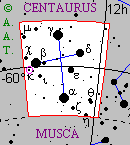 |
 |
| English name | Southern Cross | ||||
|---|---|---|---|---|---|
| Major stars | alpha Crucis | Acrux | magn. 0,9 | RA: 12h 26m 35.96s | Dec: -63° 05' 56.5" |
| beta Crucis | Mimosa | magn. 1,4 | RA: 12h 47m 43.30s | Dec: -59° 41' 19.3" | |
| gamma Crucis | Gacrux | magn. 1,6 | RA: 12h 31m 09.95s | Dec: -57° 06' 47.0" | |
| delta Crucis | magn. 3,1 | RA: 12h 15m 08.69s | Dec: -58° 44' 55.8" | ||
| Description | Crux is the smallest constellation of the whole sky, but it is also one of the most famous and characteristic. It is between Centaurus' legs. Acrux, the principal star of the constellation, is the fourteenth star in order of brightness: it is a double formed by two white-blue components, of magnitude 1,4 and 1,9. Another couple of white-blue stars, though less shining, is my Crucis.
|
||||
| Mythology and history | The Greeks too knew the Southern Cross, but they considered its stars as share of the Centaurus' hind legs. It was probably the Italian navigator Andrea Corsali who described it for the first time, in 1516: Crux, he wrote, is so fair and beautiful that no other heavenly sign can be compared to it. The cross was used by the sailors to individualize the South Pole and the astronomers considered it as a distinct constellation beginning from the end of the XVI century. | ||||
 Back to constellations page.
Back to constellations page.